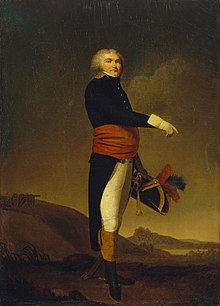Jean-Baptiste Kléber
Jean-Baptiste Kléber | |
|---|---|
General of division | |
| Commands held | 4th Haute-Rhin Battalion Army of Sambre and Meuse Army of the Orient |
| Battles/wars | |
| Awards | Inscription on the Arc de Triomphe (Southern Pillar, Column 23) |
| Signature | |
Jean-Baptiste Kléber (IPA: [ʒɑ̃ batist klebɛʁ]) (9 March 1753 – 14 June 1800) was a French military leader of the French Revolutionary Wars. After serving for one year in the French Royal Army, he entered Habsburg service seven years later. However, his humble birth hindered his opportunities. Eventually, he volunteered for the French Revolutionary Army in 1792 and quickly rose through the ranks.
Kléber served in the
A trained architect, Kléber, in times of peace, designed a number of buildings.[1]
Early career
Jean-Baptiste Kléber was born on 9 March 1753 in
Architecture

On returning to France, Kléber received the appointment of inspector of public buildings at
French Revolutionary Wars

In 1792, at the start of the
Kléber was then posted to the
When Kléber openly expressed his opinion that the Vendéans merited lenient measures, the authorities recalled him, but reinstated him once more in April 1794 and sent him to the Army of the Ardennes.[2][7] He displayed his skill and bravery in the numerous actions around Charleroi, and especially in the crowning victory at Fleurus (26 June 1794).[2] During the following years he served mostly in the Army of Sambre and Meuse on the Rhine frontier.[7] In the winter of 1794–1795 he besieged Mainz.[2] In 1795, and again in 1796, Kléber held the chief command of the army temporarily, but declined a permanent appointment as commander-in-chief.[2]
On 13 October 1795 he fought a brilliant rearguard action at the bridge of Neuwied, and in the offensive campaign of 1796, he served as General Jean-Baptiste Jourdan's most active and successful lieutenant, with his victory at Siegburg on 1 June that year enabling Jourdan to get the bulk of the French force across the Rhine.[2] After the retreat to the Rhine, Kléber again declined a chief command, and retired into private life in early 1798.[2] He returned to service later that year, first in the Army of England, then accepted a division in the Army of the Orient under General Napoleon Bonaparte.[7]
Egyptian campaign

Kléber followed Bonaparte in his expedition to Egypt but suffered a wound in the head at Alexandria in the first engagement, which prevented him for taking part in the Battle of the Pyramids, and caused his appointment as governor of Alexandria.[2] In the Syrian campaign of 1799, however, he commanded the vanguard, took El-Arish, Gaza, and Jaffa, and won a great victory at the Battle of Mount Tabor on 15–16 April 1799.[2]
The campaign was not going well for the French as Napoleon withdrew and returned to France towards the end of 1799. Napoleon left Kléber in command of the French forces, without consulting Kléber before leaving.
Kléber, son of an operative mason and a prominent freemason himself, was attestedly instrumental in bringing freemasonry to Egypt.
Assassination

Shortly after these victories, while Kléber was walking in the garden of the palace of Alfi bika, he was stabbed to death by
Burial

After his assassination, Kléber's embalmed body was repatriated to France.
Assessment
Kléber emerged as undoubtedly one of the greatest generals of the French revolutionary epoch. Though he distrusted his powers and declined the responsibility of supreme command, there is nothing in his career to show that he would have been unequal to it. As a second-in-command no general of his time excelled him. His conduct of affairs in Egypt, at a time when the treasury was empty and the troops were discontented for want of pay, shows that his powers as an administrator were little, if at all, inferior to those he possessed as a general.[2] While Kléber himself had a mixed view of Napoleon (including cursing at him and drawing mocking caricatures of him), Bonaparte thought highly of Kléber's skill, stating that there was, "No sight so splendid as watching Kléber go into battle", and he likened him to the God of War Mars.[16]
See also
- Lycée Kléber
- Place Kléber
- Kléber (Paris Métro)
- Kléber (train)
- Manfred Stern, Austrian-born Soviet officer who gained fame in the Spanish Civil War under the pseudonym "General Kléber"
Notes
- ^ Jensen, Nathan D. "General Jean-Baptiste Kléber". frenchempire.net. Retrieved 16 February 2016.
- ^ a b c d e f g h i j k l m n o p Chisholm 1911.
- ^ Phipps 2011, p. 141.
- ^ "Hôtel de ville de Thann". patrimoine.alsace. Archived from the original on 24 February 2016. Retrieved 15 February 2016.
- ^ "Château, puis tréfilerie et usine de petite métallurgie dites le Château". actuacity.com. Retrieved 15 February 2016.
- ^ "Abbaye de bénédictines Saint-Léger". actuacity.com. Retrieved 16 February 2016.
- ^ a b c d e f g Bertaud, Jean-Paul. "KLEBER, Jean-Baptiste (1753-1800), général". Dictionnaire Napoléon. Éditions Fayardurl.
- ^ ISBN 978-1718863620.
- ^ JSTOR 195148.
- ^ Dictionnaire universelle de la Franc-Maçonnerie (Marc de Jode, Monique Cara and Jean-Marc Cara, ed. Larousse, 2011)
- ^ La franc-maçonnerie révélée aux profanes (Pierre Ripert – ed. Presses de Chatelet- 2009)
- ISBN 978-1-351-60510-6.
- ^ "Halabi, Suleiman al-". 31 December 2009. Archived from the original on 31 December 2009.
- ^ "Tour nécropolitain du métropolitain – 2nde partie : de J à Q – Cimetières de France et d'ailleurs". landrucimetieres.fr.
- ^ "Kléber après Kléber (1800-2000) – Jean Paul Baillard". parutions.com.
- ISBN 0306807572.
Attribution:
- This article incorporates text from a publication now in the public domain: Chisholm, Hugh, ed. (1911). "Kléber, Jean Baptiste". Encyclopædia Britannica. Vol. 15 (11th ed.). Cambridge University Press. p. 845.
References
- ISBN 978-1-908692-25-2.
Further reading
- Philippe Jéhin, Jean-Baptiste Kléber : le lion indomptable : 1753-1800, Éditions Vent d'Est 2012, ISBN 979-10-90826-06-9
- Auguste Echard: J.-B. Kléber : un fils de l'Alsace, Charavay Frères Éditeurs, Paris, 1883 (sic) online version
